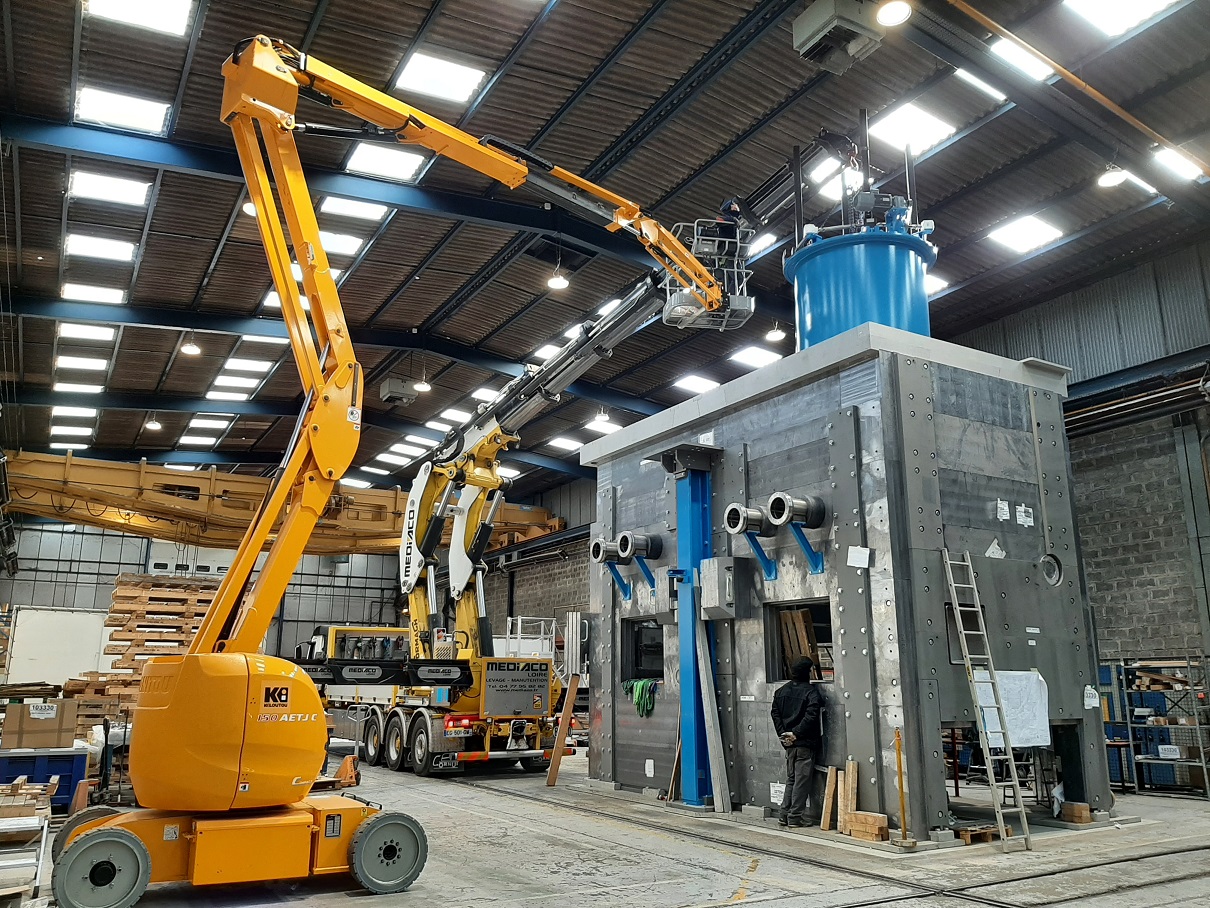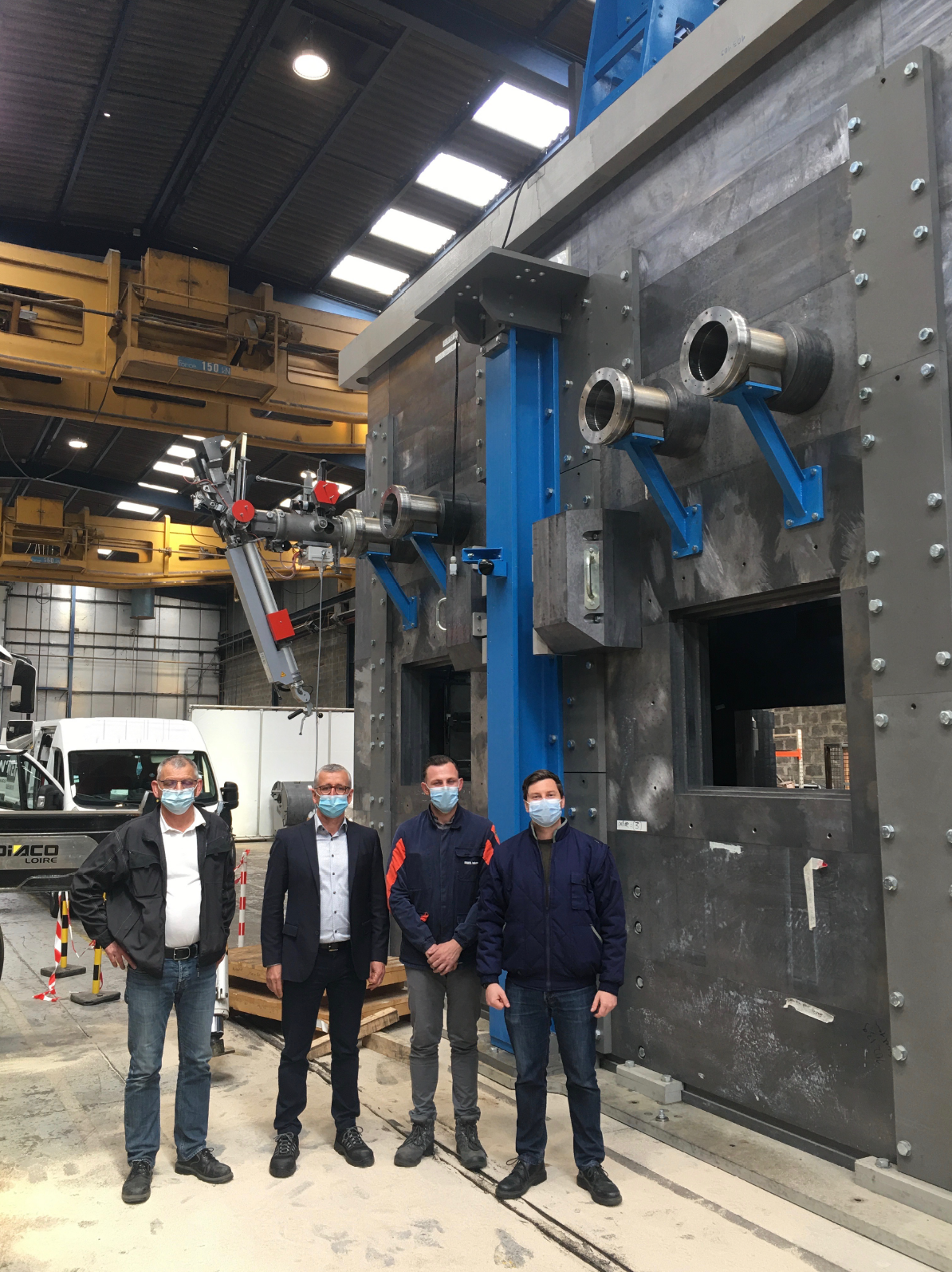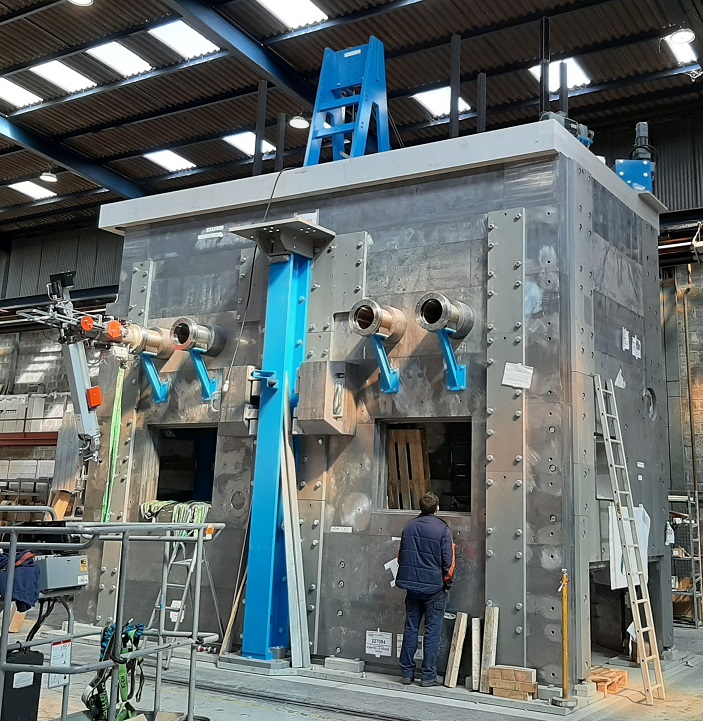The first of two hot cells to be installed in TRIUMF’s ARIEL (Advanced Rare Isotope Laboratory) has begun factory acceptance testing, marking a critical milestone for ARIEL design and engineering teams.
 (image: ARIEL hot cell 1)
(image: ARIEL hot cell 1)
TRIUMF has commissioned French company ROBATEL, with support from Getinge La Calhène, for the construction and testing of ARIEL’s first hot cell, which is just one of the two lead-shielded, room-sized units being built to allow the safe handling of radioactive items as a part of ARIEL’s rare isotope beam (RIB) delivery paradigm. Specifically, the cell will allow for remote handling of target assemblies, repair and maintenance of modules, and disposal of radioactive waste.
Globally, there are just a handful of vendors with the expertise and capacity to build hot cells for such use-cases. For TRIUMF, the factory acceptance test results will play an important role in validating the design, engineering, and assembly work, and in solidifying an important relationship with the companies as teams look to the second hot cell production and beyond.
“We are very happy to collaborate with ROBATEL and Getinge La Calhène on this critical project,” said Adam Newsome, TRIUMF Remote Handling Mechatronics Engineer and one of the project leads for the hot cell production. “Our TRIUMF teams have worked around the clock to continue pushing this progress for ARIEL, and we are very eager to see the results of this work validated in the hot cell factory acceptance testing.”
Put to the test
Hot cells present some of the most significant design and engineering challenges in radioactive waste handling and maintenance on activated equipment. They are multifaceted and highly complex, requiring shielding enough to withstand radiation-intense conditions in order to protect the operators and other people working nearby. They feature specialized air environments to prevent the spread of contamination and allow for work on chemically reactive items. Further, the equipment within the hot cell must be designed to prevent the possibility of failure and allow for remote maintenance via manipulators or cranes.
Factory acceptance testing assesses the construction and function of the assembled hot cell and confirms that all requirements for proper function have been met. That list of figures and parameters numbers in the hundreds, from physical dimensions and specifications, range of motion assessments for different components, lift and weight capacities, and a variety of other calculations.

(image: the ROBATEL team next to the hot cell)
The testing and results are documented rigorously with photos, video, and other data collection, which is sent to TRIUMF for review. TRIUMF has appointed French consultant Noell International to attend the testing in-person on our behalf and provide a report.
After the TRIUMF team approves the results, the hot cell can be disassembled and packed for its six-week-long Atlantic Ocean passage and shipment to Vancouver.
Once the hot cell components are received and assembled at TRIUMF, ARIEL teams will begin the process of connecting mechanical services (including lines for argon gas, ventilation, etc.) and electrical power supplies, controls integration, and testing specifications like the shielding capacity.
Teams are on-track to have the general structure of the hot cell housing completed by February 2022. By March of 2022, Newsome and his colleagues hope to be able to begin site acceptance testing (SAT), which will test the hot cell in situ against its requirements specifications. This will include the insertion and removal of real modules and hermetic target vessels, checking ventilation, load testing of the turntables, assessing safety systems, and more.
“While there's a tremendous amount of work left to do in the overall progress towards hot cell completion, we are thrilled to see the first one ‘up and running’ over at ROBATEL,” said Newsome. “It’s a real moment of triumph for the many people who have contributed to the hot cell design and engineering so far.”
A new paradigm for RIB production at TRIUMF
Hot cells play a critical role in the wider RIB system, enabling safe storage and processing space for targets that have completed their schedule of irradiation.
At the heart of the isotope production system, the target station, a shoebox-sized target assembly holds target material in a cigar-shaped tube made of tantalum. The tube is also known as the ‘target oven’ because it’s electrically heated to more than 2000 ºC inside of a high-vacuum environment. The target container is surrounded by a copper heat shield which is cooled by a recirculating water system that can extract 50kw of energy (which is comparable to a compact car engine – all from a volume as small as a cigar!). Due in part to the harsh thermal and radiological conditions, the operational life for each target is only about five weeks, calling for frequent remote target exchanges to limit downtime.
Building on the designs developed for TRIUMF’s Isotope Separator and Accelerator (ISAC) facilities, ARIEL’s targets will be contained in a new hermetically sealed (air-tight) vacuum container. This briefcase-sized aluminium container will enable the use of modern target and ion source technology and a much faster and easier ‘plug-and-play’-style exchange of spent targets. Instead of remotely moving the entire 10-ton target module to a hot cell for the target exchange (as is required by the ISAC paradigm), the hermetically sealed ARIEL target containers can be directly exchanged.

(image: the ARIEL hot cell undergoing factory acceptance testing)
With the advent of the ARIEL operation, TRIUMF will move to a 3-week production cycle for each target, introducing a heartbeat-like operating module in which one of the three ISOL targets is exchanged each week. By reducing the overall downtime to just a few days, teams will significantly increase the efficiency of RIB delivery for TRIUMF experiments.
Hot cell 1 will play a critical role by adding capacity for repair and maintenance of the target modules, as well as serving as an intermediary storage space in the rare case of crane failure during the transport of modules to the module storage pit. The additional storage and maintenance capacity will significantly ease the strains of the current target exchange paradigm and expand the historically razor-thin margin for error under which target teams have operated.
“Everything about the design and engineering of our RIB delivery system at ARIEL reflects a long history of focused learning and advancement in technologies for target systems design, remote handling capabilities with the overhead crane, shielding, and hot cell design,” said Eric Guetre, Director, Project Management. “Leveraging our two driver beams, the innovative CANREB system, and unique target and target processing facilities, ARIEL will position TRIUMF at the forefront of multi-user rare isotope facilities globally. The hot cell factory acceptance testing is an important step in our journey towards ARIEL’s completion, and I am tremendously proud of our teams’ progress and continued hard work.”
The ARIEL hot cell design, management, engineering, and other supporting team members include Adam Newsome, Chad Fisher, Eric Guetre, Sam Varah, Mike McLay, Isaac Earle, Michael Genix, Mel Almario, Bill Richert, Adrian Watt, Julie Cho, Joe Mildenberger, Max Kinakin, Dragan Mitrovic, Dan McDonald, Maico Dalla Valle, Grant Minor, Pierre Bricault, Alex Gottberg, Diego Pinto, Kai-Mei Chu, Bill Paley, Barry Shorr, Ricardo dos Santos Augusto, Franco Mammarella, and Jason Chak.
Congratulations, ARIEL design and engineering teams!
